
Musaceae is a family of flowering plants composed of three genera with about 91 known species, placed in the order Zingiberales. The family is native to the tropics of Africa and Asia. The plants have a large herbaceous growth habit with leaves with overlapping basal sheaths that form a pseudostem making some members appear to be woody trees. In most treatments, the family has three genera, Musa, Musella and Ensete. Cultivated bananas are commercially important members of the family, and many others are grown as ornamental plants.

Musa is one of three genera in the family Musaceae. The genus includes 83 species of flowering plants producing edible bananas and plantains, and fiber (abacá), used to make paper and cloth. Though they grow as high as trees, banana and plantain plants are not woody and their apparent "stem" is made up of the bases of the huge leaf stalks. Thus, they are technically gigantic herbaceous plants.
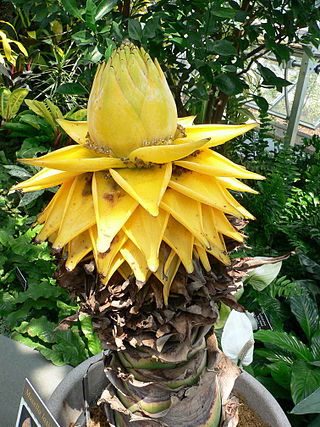
Musella lasiocarpa, commonly known as Chinese dwarf banana, golden lotus banana or Chinese yellow banana, is the sole species in the genus Musella. It is thus a close relative of bananas, and also a member of the family Musaceae.

Musa basjoo, known variously as Japanese banana, Japanese fibre banana or hardy banana, is a species of flowering plant belonging to the banana family Musaceae. It was previously thought to have originated in the Ryukyu Islands of southern Japan, from where it was first described in cultivation, but is now known to have originated in subtropical southern China, where it is also widely cultivated, with wild populations found in Sichuan province. Its specific name is derived from its Japanese common name, bashō (芭蕉).
Musa maclayi is a species of seeded banana native to Papua New Guinea and the Solomon Islands. It is placed in section Callimusa. It is regarded as one of the progenitors of the Fe'i banana cultivars.
Musa salaccensis, commonly called Javanese wild banana, is a Malesian tropical species of plant in the banana family native to the islands of Sumatra and Java, in Indonesia. It is placed in section Callimusa, members of which have a diploid chromosome number of 2n = 20.
Musa insularimontana is a species of plant in the banana family native to Taiwan, where it is known by the name lan yu ba jiao. It is placed in section Callimusa, having a diploid chromosome number of 2n = 20.

Musa coccinea, commonly known as scarlet banana or red-flowering banana, is a species of flowering plant in the banana and plantain family Musaceae, native to tropical China and Vietnam. It is a bat-pollinated evergreen perennial, placed in section Callimusa, having a diploid chromosome number of 2n = 20.
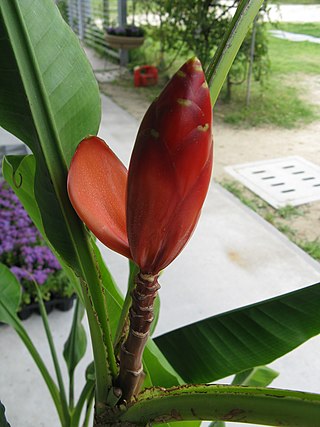
Musa beccarii is a species of wild banana, found in Malaysia, in Sabah. It is placed in section Callimusa.

Musa jackeyi, commonly called the erect banana or wild banana, is a species of wild banana in the plant family Musaceae. It is placed in section Callimusa. It has a very small native range in northeast Queensland, Australia. It grows up to 10 m (33 ft) in height, with leaf blades usually about 2 m long by 60 cm (24 in) wide. It resembles the cultivated bananas called "fe'i" or "fehi", having an upright rather than a drooping fruit stalk, with the green terminal bud pointing upwards, and sap which is reddish in colour.
Musa boman is a species of wild banana, native to the West Sepik (Sandaun) Province of Papua New Guinea, in the eastern portion of the island of New Guinea. It is placed in section Callimusa, having a diploid chromosome number of 2n = 20. The male bud is cream in colour.
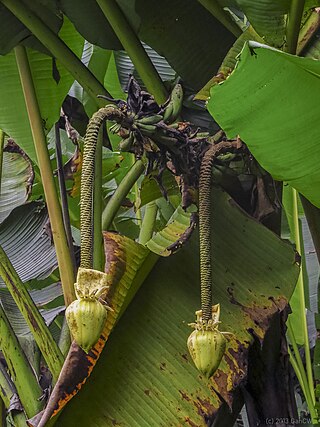
Musa borneensis is a species of wild banana, native to the island of Borneo, in the Malaysian states of Sabah and Sarawak. It is placed in section Callimusa, having a diploid chromosome number of 2n = 20.
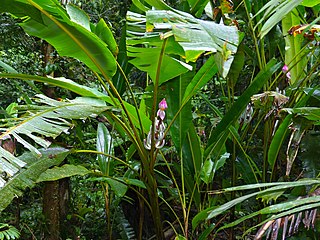
Musa campestris is a species of wild banana, endemic to the island of Borneo. It is placed in section Callimusa, having a diploid chromosome number of 2n = 20.
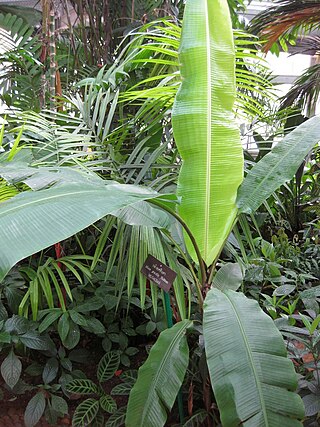
Musa gracilis is a species of wild banana, native to Peninsular Malaysia. It is placed in section Callimusa, having a diploid chromosome number of 2n = 20. It grows to less than 2 m (7 ft) tall. It has an upright pink-purple bud and produces narrow fruits (bananas), which have magenta and green stripes.
Musa lawitiensis is a species of wild banana, native to the island of Borneo. It is placed in section Callimusa, having a diploid chromosome number of 2n = 20.

Musa lolodensis is a species of wild banana, occurring naturally from the Moluccas through to New Guinea. It is placed in section Callimusa, having a diploid chromosome number of 2n = 20. It is one of the possible parents of the cultivated Fe'i bananas.
Musa monticola, also known as the Kinabalu mountain banana, is a species of wild banana, native to Sabah on the island of Borneo. It is placed in section Callimusa, having a diploid chromosome number of 2n = 20.
Musa peekelii is a species of wild banana, native to eastern New Guinea and the Bismarck Archipelago. It is placed in section Callimusa, members of which have a diploid chromosome number of 2n = 20. It is a very tall plant, reaching over 10 m (33 ft), with a narrow green drooping bud. The ripe bananas are red with bright yellow flesh. It is one of the possible parents of the cultivated Fe'i bananas.

Musa violascens is a species of wild banana, native to Peninsular Malaysia. It is placed in section Callimusa, members of which have a diploid chromosome number of 2n = 20.

Musa banksii is a species of wild banana, native to New Guinea and Australia (Queensland), and most likely introduced to Samoa. It was first described by Ferdinand von Mueller in 1863 from plants collected in Queensland, Australia. Thereafter, taxonomists have variously treated it as a unique species or as a subspecies of Musa acuminata. The first one to note an affinity with Musa acuminata was Ernest E. Cheesman in 1948. In 1957, Norman Simmonds reclassified it as a subspecies of Musa acuminata based on extensive field observations in New Guinea, Australia, and Samoa. In 1976, George Argent chose to treat it as a species.













